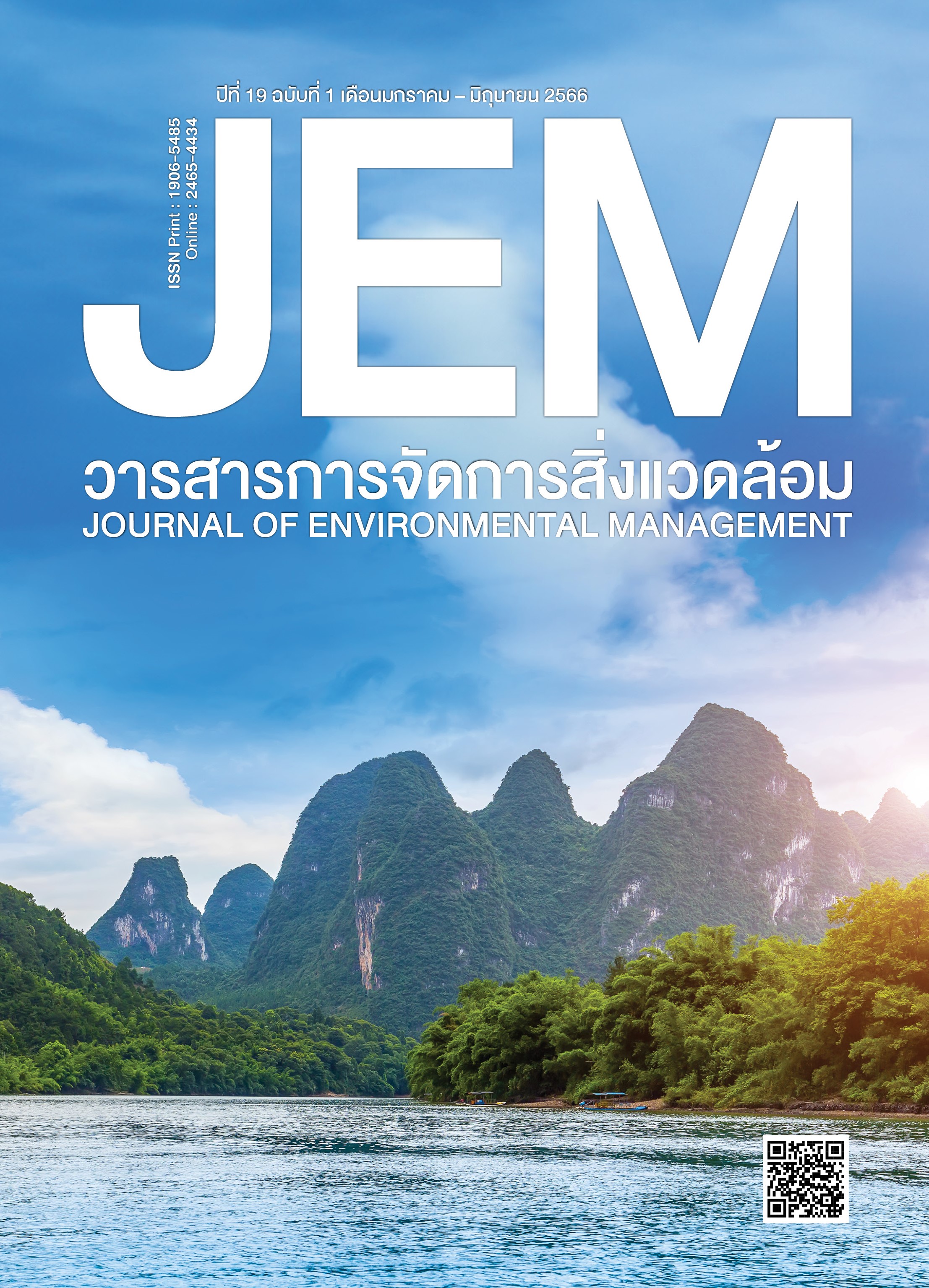บทบาทของมหาวิทยาลัยในการพัฒนาเมืองน่าอยู่ผ่านกระบวนการมีส่วนร่วม
DOI:
https://doi.org/10.14456/jem.2023.2คำสำคัญ:
การพัฒนาเมืองน่าอยู่, กระบวนการร่วมพัฒนาแบบภาคี 4 ฝ่าย, บทบาทของมหาวิทยาลัย, กรุงเทพมหานครบทคัดย่อ
การพัฒนาย่านเมืองที่น่าอยู่ควรมีส่วนร่วมของสถาบันการศึกษา ธุรกิจเอกชนและประชาชนในย่านพื้นที่ การวิจัยนี้มีวัตถุประสงค์เพื่อศึกษากระบวนการร่วมพัฒนาเมืองของสถาบันบัณฑิตพัฒนบริหารศาสตร์ (NIDA) ในการขับเคลื่อนเมืองน่าอยู่อย่างมีส่วนร่วมในพื้นที่ย่านบางกะปิ กรุงเทพมหานคร และเพื่อถอดบทเรียนนี้สู่การพัฒนาเมืองต่อไป เป็นการวิจัยเชิงคุณภาพประกอบด้วยการทบทวนวรรณกรรม การสัมภาษณ์เชิงลึก การสอบถามภาคีร่วมพัฒนาและตรวจสอบสามเส้าด้านข้อมูล (Method triangulation) เพื่อสรุปบทบาทของ NIDA ในการขับเคลื่อนการพัฒนา ถอดบทเรียนและกำหนดเป้าหมายการพัฒนาเมืองน่าอยู่สำหรับย่านบางกะปิ
ผลการศึกษาพบว่า ด้านกระบวนการ NIDA มีบทบาทประสานการพัฒนาเมืองแบบ 4 ฝ่าย (Quadruple-Helix Collaboration) ระหว่าง ฝ่ายรัฐ คือ กรุงเทพฯ ฝ่ายวิชาการ คือ NIDA ฝ่ายธุรกิจ คือ กลุ่มห้างสรรพสินค้า และฝ่ายประชาชน คือ เจ้าของที่ดินดั้งเดิม ผู้แทนชุมชน กลุ่มศาสนา สมาคมนักศึกษาเก่าฯ และอื่นๆ ด้านบทเรียนการพัฒนาเมือง พบว่า ย่านบางกะปิเป็นจุดเชื่อมต่อการเดินทางระบบขนส่งมวลชนและส่วนบุคคลทางถนน ทางรางและทางน้ำอย่างครบครัน จึงมีศักยภาพพัฒนาสู่เป็นประตูและศูนย์กลางเมืองด้านตะวันออกของกรุงเทพฯ ประกอบด้วยย่านพาณิชกรรม การศึกษา การอยู่อาศัย การเดินทางและอื่นๆ จึงควรกำหนดเป้าหมายการเติบโตเป็นย่านเมืองกระชับตัว (Compact city) พร้อมทั้งป้องกันการขยายตัวอย่างไร้ระเบียบ (Urban sprawl) ของกรุงเทพฯ เพื่อเป็นเมืองที่น่าอยู่อย่างยั่งยืน
เอกสารอ้างอิง
British Council. (n.d.). Smart Places: How universities are shaping a new wave of smart cities. Retrieved Jan. 25th , 2022, From https://www.britishcouncil.org/sites/default/files/smart_places_report.pdf.
Coffey, B., & Dierwechter, Y. (2005). The Urban university as a vehicle for inner-city renewal. The University as Urban Developer: Case Studies and Analysis, 80. Retrieved June 25th , 2022, from https://books.google.co.th/books?id=vmcgIYDVWoIC&lpg=PA80&ots=fFJfkmTYss&lr&hl=th&pg=PA82#v=onepage&q&f=true.
Cohen, J.M., & Uphoff, N.T. (1980). Participations place in rural development: Seeking Clarity through specificity. New York: World Developments.
Duany, A., Roberts, P., & Tallen, E. (2014). A General theory of urbanism - Towards a system of assessment based on garden city principles (Draft version). Miami: Duany Plater-Zyberk & Company. Retrieved July 2nd, 2022, from https://www.scribd.com/document/266811707/A-General-Theory-of-Urbanism.
European Parliamentary. (2014). Mapping Smart Cities in the EU. Brussels: European Union. Retrieved June 5th , 2022, from https://www.europarl.europa.eu/RegData/etudes/etudes/join/2014/507480/IPOL-ITRE_ET(2014)507480_EN.pdf.
Hall, P. (2014). Cities of tomorrow: An intellectual history of urban planning and design since 1880 (4th ed.). Chichester: Wiley Blackwell.
Le Goix, R. (2003). Les ‘gated communities’ aux Etats Unis. Morceaux de villes ou territoires à part entière? (Doctoral Dissertation). Panthéon-Sorbonne, Paris, France.
Initiative for a Competitive Inner City (ICIC) and CEOs for Cities. (2002). Leveraging colleges and universities for urban economic development: An action agenda. Boston: CEOs for Cities. Retrieved Sep. 15th, 2022, from https://economyleague.org/uploads/files/800422144961444642-leveraging-colleges-and-universities-for-urban-economic-revitalization.pdf.
Klubsuwan, K. (2018). Smart Virtual City Management integrated with Complete Intelligence National Security to bring Thailand into Thailand 4.0. [In Thai]. The Report of National Defense Course (Science and Technology Field): National Defense College of Thailand.
Nophaket, N. (2021). Creating Mechanism for Smart-Livable District of Bang Kapi - NIDA to enhance the Economic and Society of Bangkok. [In Thai]. (Full research report). Program Management Unit on Area-based Development. Office of National Higher Education Science Research and Innovation Policy Council, Thailand.
Kullatat Hongchayangkool. (n.d.). Network creation and administration. Retrieved Dec. 14th, 2022, from http://hsmi2.psu.ac.th/upload/forum/paper_1598_5f69ce9304e915f69ce.pdf.
Nunthatraipob, N. (2018). Smart Environment City. Information Library of the Legislative Institute. Retrieved June 25th, 2022, from https://www.parliament.go.th/ewtadmin/ewt/parliament_parcy/ewt_dl_link.php?nid=51480&filename=house2554.
Kokpol, O. (2009). Your Partner, Public Participation Handbook for Local Administrators. Charansanitwong printing.
Kokpol, O. (2016). Urbanization when “city” becomes a problem of modern local management. Sun packaging.
M. Lindfield, & F. Steinberg. (2012). Green cities for Asia and the Pacific. Asian Development Bank. Retrieved Nov. 3rd, 2022, from http://www.adb.org
Perry, D. C., Wiewel, W., & Menendez, C. (2009). The university’s role in urban development: From enclave to anchor institution. Land Lines, 21(2), 2-7.
Prawanne, C. (2020). The Process of Transformation into a Smart City: A Case Study of Khon Kaen Municipality. Local Administration Journal, 13(3), 267–284.
Safdie, M., & Kohn, W. (1997). The city after the automobile: An architect’s vision. Toronto: Stoddart Publishing Co., Limited.
Vernet, N., & Coste, A. (2017). Garden Cities of the 21st Century: A Sustainable Path to Suburban Reform. Urban Planning, 2(4), 45-60.
Webster, C. (2001). Gated cities of tomorrow. The Town Planning Review, 72(2), 149–170.



